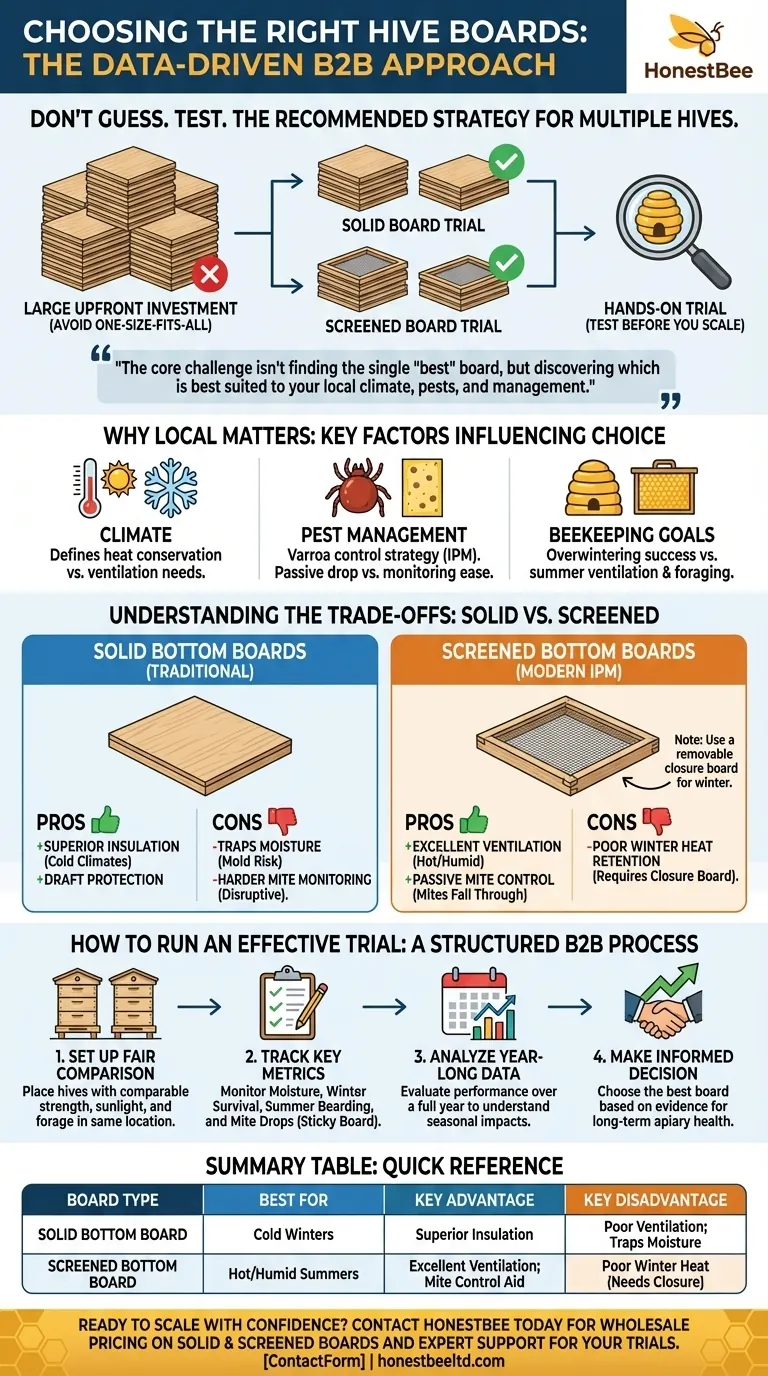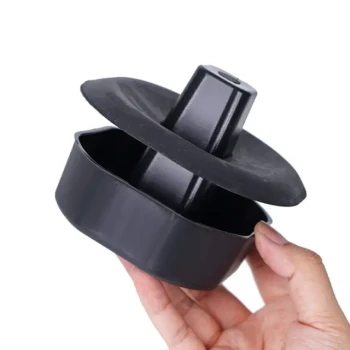For beekeepers managing multiple hives, the recommended approach for choosing between different board types is not to make a large, uniform investment upfront. The most effective strategy is to purchase a small number of different styles—such as one solid and one screened bottom board—and conduct a hands-on trial. This allows you to gather direct evidence of what works best for your bees in your specific location before committing to a larger purchase.
The core challenge isn't finding the single "best" hive board, but discovering which board is best suited to your local climate, pest pressures, and management style. A small-scale, direct comparison is the most reliable way to make a cost-effective, long-term decision for your apiary.

The Flaw in a "One-Size-Fits-All" Approach
Beekeeping is a profoundly local practice. A technique that leads to a thriving colony in one region can be detrimental in another. This is why a simple recommendation to buy one type of board for all your hives is poor advice.
Climate is the Defining Factor
The primary function of a bottom board is to control the hive's internal environment. A solid bottom board is excellent for conserving heat, which is a major advantage in regions with long, cold winters.
Conversely, a screened bottom board provides superior ventilation. This is critical in hot and humid climates to prevent the colony from overheating and to reduce moisture buildup that can lead to mold and disease.
Pest Management Strategy
The Varroa mite is a primary threat to honeybee colonies. A screened bottom board is a key component of an Integrated Pest Management (IPM) strategy.
As mites fall off bees, many will drop through the screen and out of the hive, reducing the overall mite load. It also allows you to perform "mite drop" counts on a sticky board below, helping you monitor infestation levels without disturbing the colony.
Your Beekeeping Goals Matter
Your choice may also depend on your operational priorities. If maximizing overwintering success is your top goal, the insulation from a solid board might be your focus.
If you are more concerned with reducing summer "bearding" (where bees gather on the outside of the hive to cool down) and promoting foraging, the ventilation from a screened board is more beneficial.
Understanding the Trade-offs
Neither board type is perfect; each comes with a distinct set of advantages and disadvantages. Understanding these is key to evaluating your trial.
Solid Bottom Boards: Pros and Cons
Solid boards are the traditional, simpler design. They offer better insulation and draft protection, making them a default choice for beekeepers in colder climates.
However, their lack of ventilation can trap moisture, especially during winter. They also make it more difficult to monitor Varroa mite populations without adding a separate sticky board insert, which can be disruptive to the bees.
Screened Bottom Boards: Pros and Cons
Screened boards are valued for providing excellent air circulation, which helps the bees regulate temperature in the summer and reduces internal condensation year-round. They are also a passive tool for mite control.
The primary drawback is poor heat retention in the winter. Most beekeepers who use them in cold climates use a removable closure board (often made of corrugated plastic or wood) to seal the bottom during the coldest months, effectively turning it into a temporary solid board.
How to Run an Effective Trial
To get clear results, your experiment should be more than just a casual observation. A structured approach will give you definitive answers.
Set Up a Fair Comparison
Place at least two hives of similar strength in the same general location. Ensure they receive comparable sunlight, wind protection, and access to forage. The only significant variable should be the type of bottom board you are testing.
Key Metrics to Track
Your decision should be based on data. Keep a simple logbook and track these key performance indicators for each hive:
- Moisture Levels: Check for condensation under the inner cover, especially in winter.
- Winter Survival & Spring Buildup: Note which colony seems stronger and builds its population faster in the spring.
- Summer Behavior: Observe if one colony is bearding more than the other on hot days.
- Pest Levels: Use a sticky board to compare Varroa mite drops between the two types.
Making the Right Long-Term Choice
After a full year of observation, you will have the data needed to make an informed investment for the rest of your apiary. Your choice will depend on what you learned.
- If your primary focus is overwintering success in a cold climate: Your trial will likely show the benefits of a solid board or a screened board with a well-sealed winter closure insert.
- If your primary focus is proactive mite management and summer ventilation: A screened bottom board is an almost essential tool, and your experiment will confirm its role in your IPM plan.
- If you seek a versatile, year-round system: Many beekeepers conclude that screened bottom boards paired with seasonal closure inserts offer the best of both worlds.
By investing in a small experiment now, you empower yourself to make the best possible decision for the long-term health and productivity of your entire apiary.
Summary Table:
| Board Type | Best For Climate | Key Advantage | Key Disadvantage |
|---|---|---|---|
| Solid Bottom Board | Cold Winters | Superior insulation and draft protection | Poor ventilation; traps moisture; harder mite monitoring |
| Screened Bottom Board | Hot/Humid Summers | Excellent ventilation; aids in Varroa mite control | Poor winter heat retention (requires a closure board) |
Ready to equip your apiary with the right hive boards?
As a leading wholesale supplier to commercial apiaries and distributors, HONESTBEE provides the durable, high-quality equipment you need to run effective trials and scale your successful operations. Let us help you make data-driven decisions for a healthier, more productive apiary.
Contact HONESTBEE today for wholesale pricing on solid and screened bottom boards and expert support.
Visual Guide

Related Products
- Langstroth Solid Bottom Board for Beekeeping
- Langstroth Screen Bottom Board for Beekeeping Wholesale
- Australian Pine Wood Langstroth Screen Bottom Board for Wholesale
- Professional Ant-Proof Beehive Stand with Integrated Moat for Beekeeping
- Black Plastic Beetle Barn Hive Beetle Trap for Beehives
People Also Ask
- What factors should be considered when choosing between a solid and screened bottom board? Make the Right Choice for Your Hive's Health
- What is the purpose of a solid bottom board in a hive? Essential for Winter Survival & Insulation
- How is the solid bottom board constructed to ensure durability? Built for Longevity with Quality Wood & Beeswax
- How does climate affect the choice of bottom board for a beehive? A Guide to Screened vs. Solid Boards
- What frame setups are available for the solid bottom boards? Choose the Right Foundation for Your Hive

















